An easy Spicy miso ramen recipe with a umami broth topped with sticky soy-marinated chicken. A simple yet scrumptious recipe that promises to have you lost in a world of umami deliciousness after just 40 minutes of cooking and prep time.
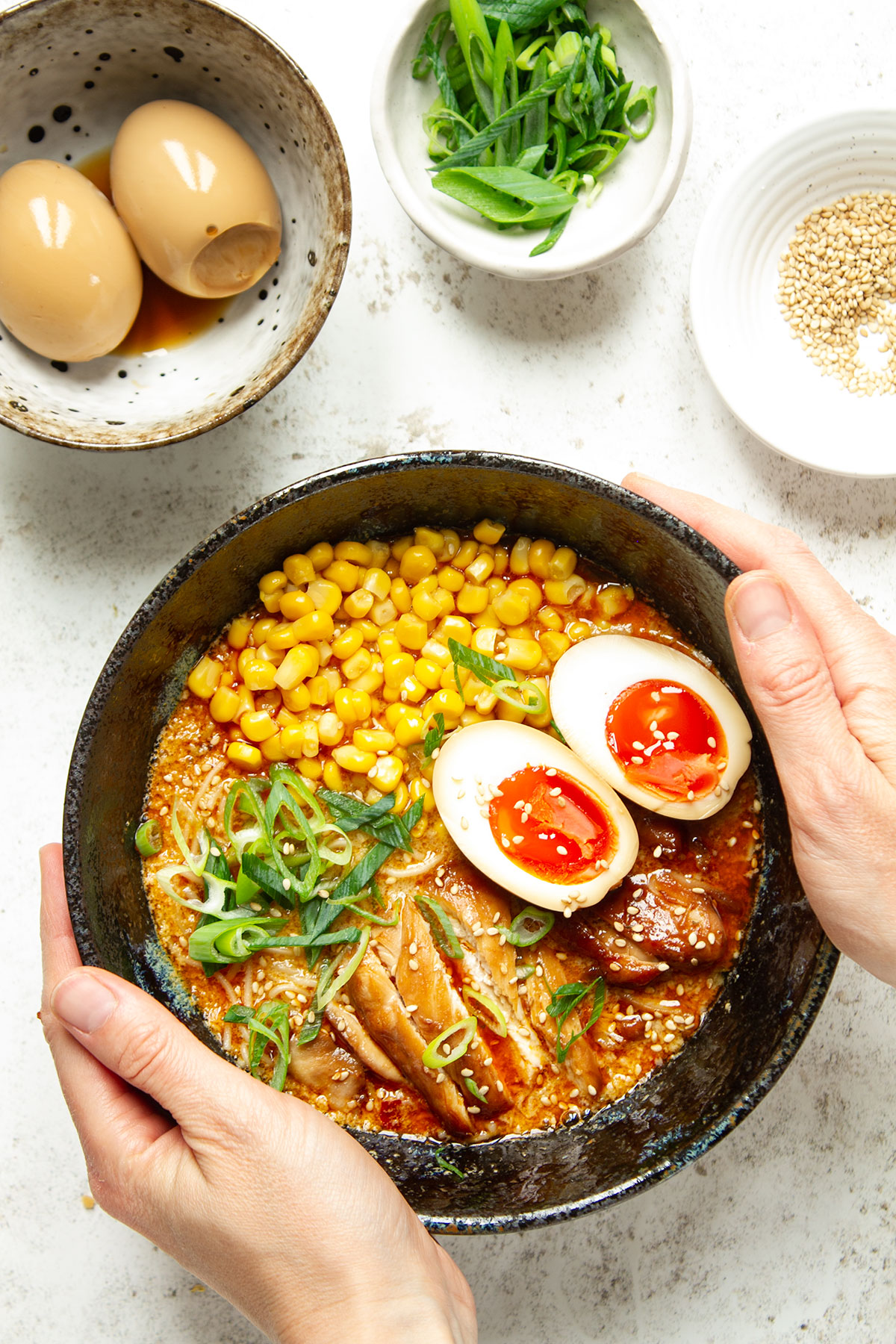
I used to think ramen was just for the weekend, when on occasion I'd spend hours simmering chicken and pork bones to make the broth and prepping braised pork belly.
I then found that regular chicken stock can be transformed into a yummy spicy miso broth with a little miso paste, soy sauce, tahini paste, and sesame oil, and that a simple soy and mirin marinade can take plain ordinary chicken thighs to a whole new level.
While I won't claim this ramen is truly authentic. I can promise you that every bowl is brimming with flavor, warming, and perfect for cold days just like this Beef Miso Ramen, Prawn Pho and Spicy Chicken Noodle Soup.
The post contains additional information and helpful tips to ensure the recipe turns out great the first time. Please use the link above to jump to the recipe card at the end if you are in a hurry!
4 reasons why you'll love this recipe:
- Delicious ramen with a creamy, spicy and umami broth
- Topped with yummy sticky chicken marinated in soy and mirin.
- Guaranteed to warm and nourish your body and soul
- Easy recipe, ready in 40 minutes
🛒 Ramen Soup Ingredients:
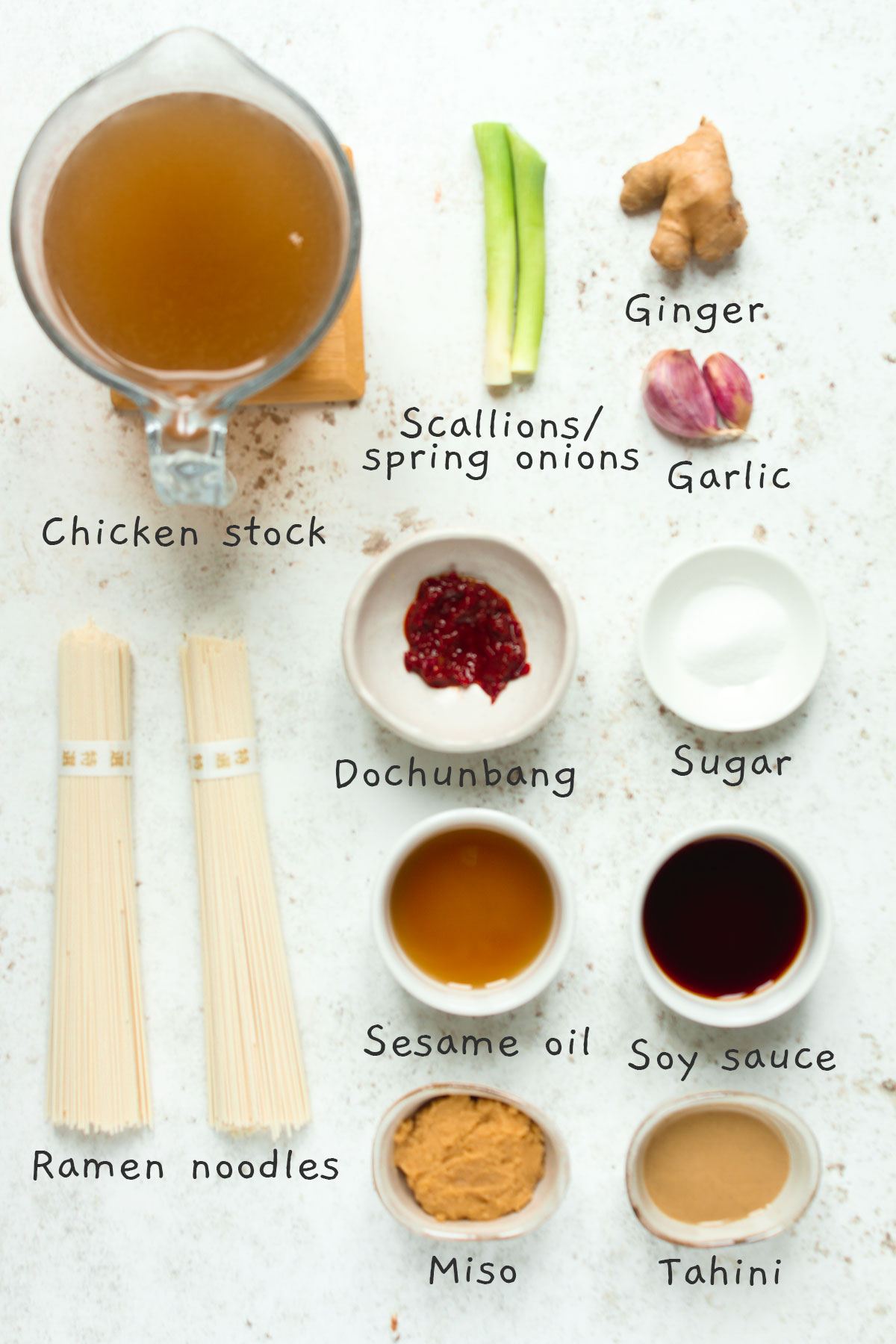
Miso tare
Ramen tare is a concentrated soup base mix that adds depth of flavor to the soup. The key ingredients in my miso tare are garlic, scallions/spring onions (white parts only), ginger, garlic, miso, soy sauce, sesame oil, doubanjiang and sugar:
Miso paste
With many varieties of miso paste (with red and white being two of the most commonly found types) you might be wondering which one is best to use.
You're likely to find white miso in your local supermarket/store and fortunately, this is the type that is best for this recipe. White miso has a light and slightly sweet flavour whereas red miso will be too strong for the broth.
Tahini
Many Japanese Ramen recipes are made with sesame paste but can be tricky to get hold of so I'm using tahini paste instead to add creamy richness to the broth.
Doubanjiang or chilli oil
Doubanjiang is a spicy Chinese bean paste that brings a slightly sweet umami flavor as well as heat. You can find it in Asian grocery stores or buy online. You can substitute it with chili paste or Chinese chili oil.
The amount of Doubanjiang suggested in this recipe gives the broth a medium level of heat. Feel free to add more if you like your ramen spicy or reduce/omit if you're sensitive to heat.
Chick broth
Traditionally, ramen broth is made by simmering pigs trotters or chicken bones for 8-10 hours. Since that's not feasible for most people, I make mine with chicken stock. Homemade is preferable, but store-bought is fine too.
I always make homemade stock using my instant pot. It's so much quicker than boiling it on the stove. If you want to try this, check out my Instant Pot Chicken Stock recipe. This is the one I always use for making ramen and other noodle soups.
Noodles
Fresh ramen noodles are great if you can find them, but you'll probably find dry noodles are more readily available. Both will work.
My favorite ramen noodles are Hime Ramen Noodles and tend to keep a packet in my pantry.
You can also use the noodles that come in instant ramen packets. Plain ramen noodles aren't always readily available, but the instant varieties never seem to be in short supply.
When it comes to ramen noodle alternatives. Egg noodles are the best fallback option.
For a gluten-free option, gluten-free ramen noodles are your best bet. Otherwise, rice noodles are a good alternative.
Toppings
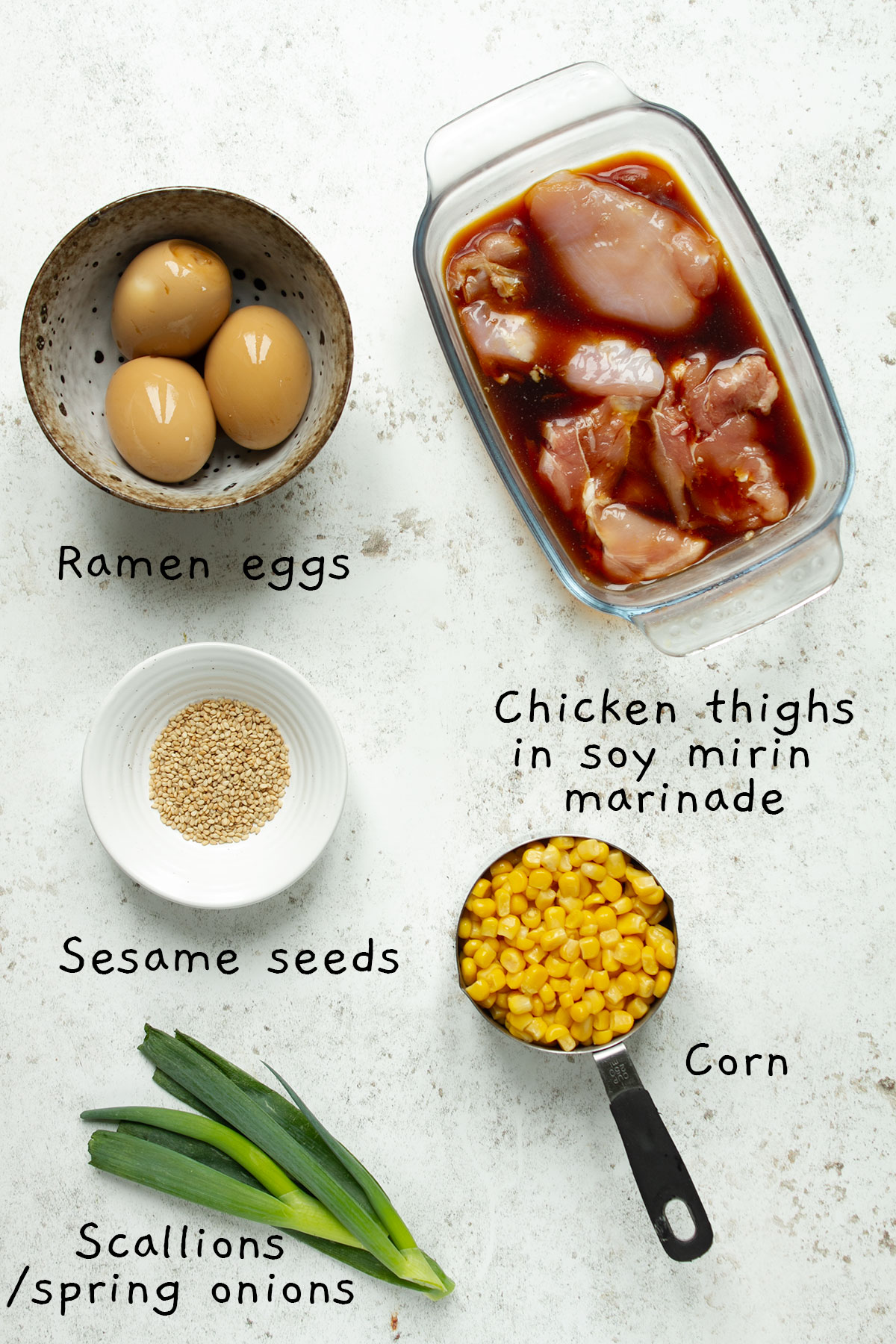
Chicken
Traditional ramen is served with Chashu, Japanese braised pork belly. Preparing it properly takes over 10 hours. To keep things simple I use chicken, which I marinade in soy sauce and mirin to give it extra flavour. I then pan fry it and pour on the marinade to make a sticky glaze.
You can use pork instead. Homemade ramen is also a great way to use up leftover cooked meats. This means you'll have to skip the marinade but you should still cook the marinade ingredients to make a glaze.
To make vegetarian miso ramen, swap the meat for tofu or fried mushrooms.
Other toppings
My favorite toppings are ramen eggs, corn, thinly sliced green parts of scallions/spring onions and a sprinkling of sesame seeds.
I highly recommend making your own ramen eggs using my Soy Marinated Ramen Eggs Recipe. You can prep them in less than 20 minutes. Then it's just a case of leaving them in the fridge to soak up the yummy umami marinade flavour.
If you haven't planned ahead plain soft-boiled eggs simmered for 6-7 minutes will still do the job.
🥘 Variations
This ramen recipe is adaptable. There are many ways to change it up to make it your own. It's also a great way to use up leftover veggies in your fridge.
- Sautéed mushrooms in addition to or instead of meat. Choose the ones you fancy, button, enoki and shiitake mushrooms all work well.
- Blanched green veg like spinach or bok choy
- Add bamboo shoots for some extra veggies
- Swap meat for tofu
- Swap the chicken stock for veg stock to make the ramen vegan/vegetarian
- Replace the chicken with cooked gyoza
- Use cooked leftover chicken/pork instead of cooking from scratch. You can add some of the glaze if you want to add more flavour
🧑🍳 Recipe steps
*Be sure to see the recipe card below for the full ingredients list & instructions!*
Step 1: Marinate the chicken. Mix mirin, soy sauce and sugar in a bowl, add the chicken thighs (ensuring you remove the fat first), and leave to marinade for 30 minutes or overnight.
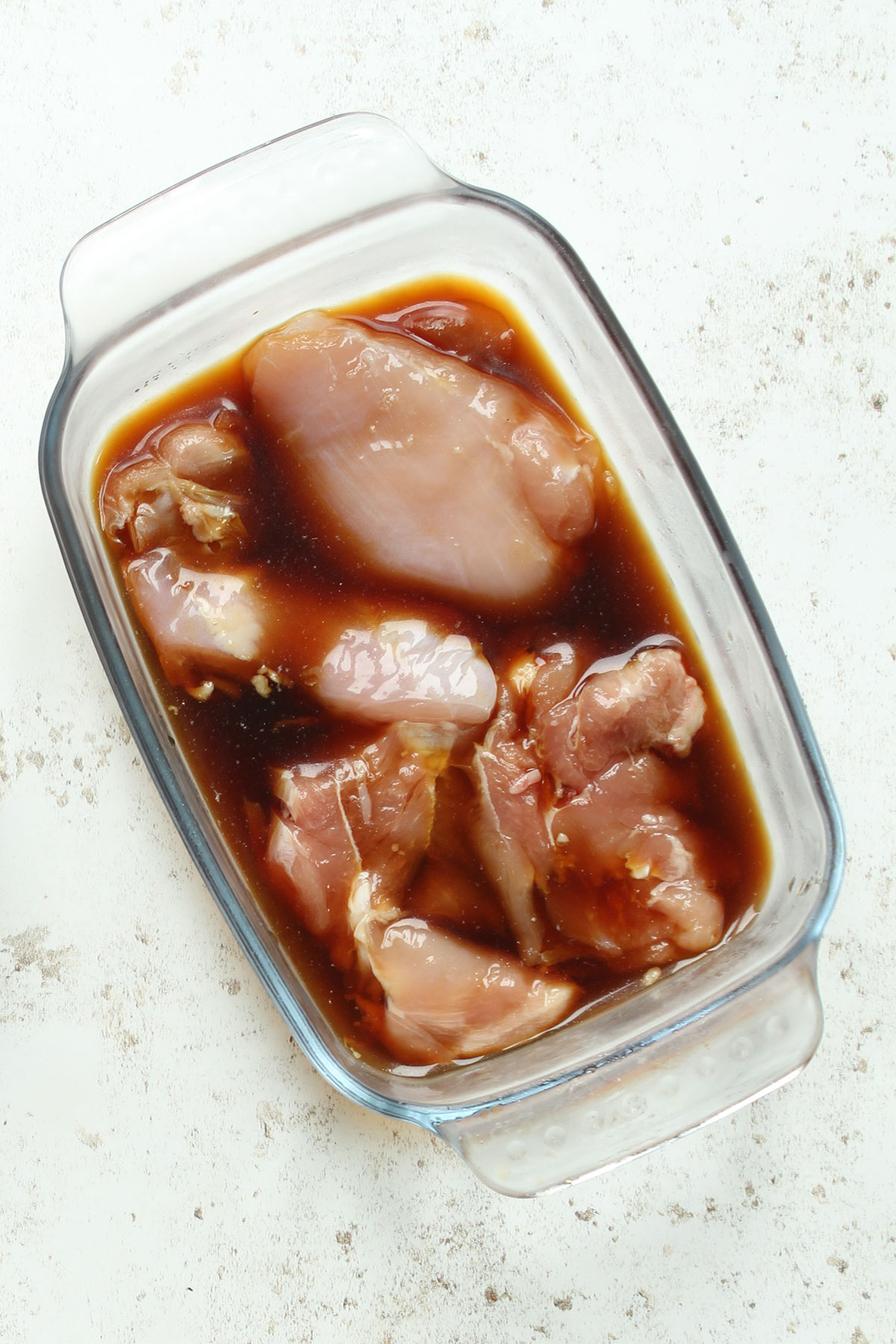
Step 2: Cook the chicken: Place a Dutch oven or frying pan on a medium-high heat and add oil. Add the chicken when the oil is hot and fry for a few minutes on each side until brown. Then pour in the marinade and leave to simmer until it reduces to a sticky glaze and the chicken is cooked through.

Step 3: Make the tare: Add a little more oil to the pot and fry the garlic, scallions/spring onions and ginger for a minute or two until fragrant. Then stir in the miso paste, tahini, sesame oil, soy sauce, chili oil and sugar.
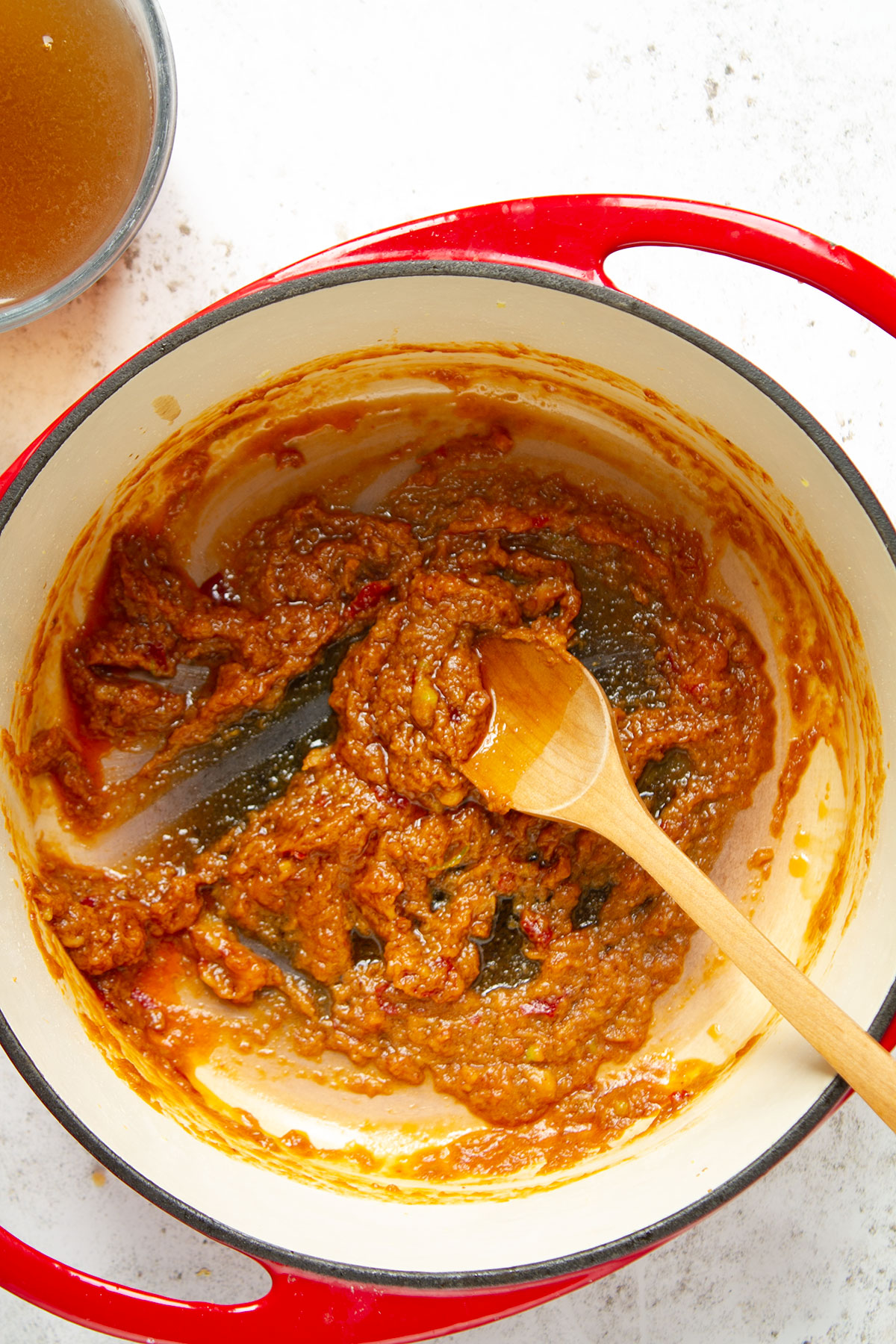
Step 4: Make the broth: Pour on the chicken stock and leave to simmer on a low heat with the lid on for 10 minutes. Meanwhile, cook the noodles in a medium pot of boiling water according to packet instructions.

Tips for cooking ramen noodles
- Wait to cook the noodles. Put them on a few minutes before you plan to assemble the ramen.
- Don't salt the water like you would for pasta. The broth will provide the flavor you need.
- Don't cook the noodles in the broth. This shortcut might be tempting, but the starchiness of the noodles will alter the flavor of your broth.
- Cook the noodles until they are still a little hard. They will cook a little more when you pour on the hot broth.
Step 5: Assemble: Add a portion of noodles to each bowl, pour on the broth and top with chicken, corn, ramen eggs, sesame seeds and the green parts of the scallions/spring onions.
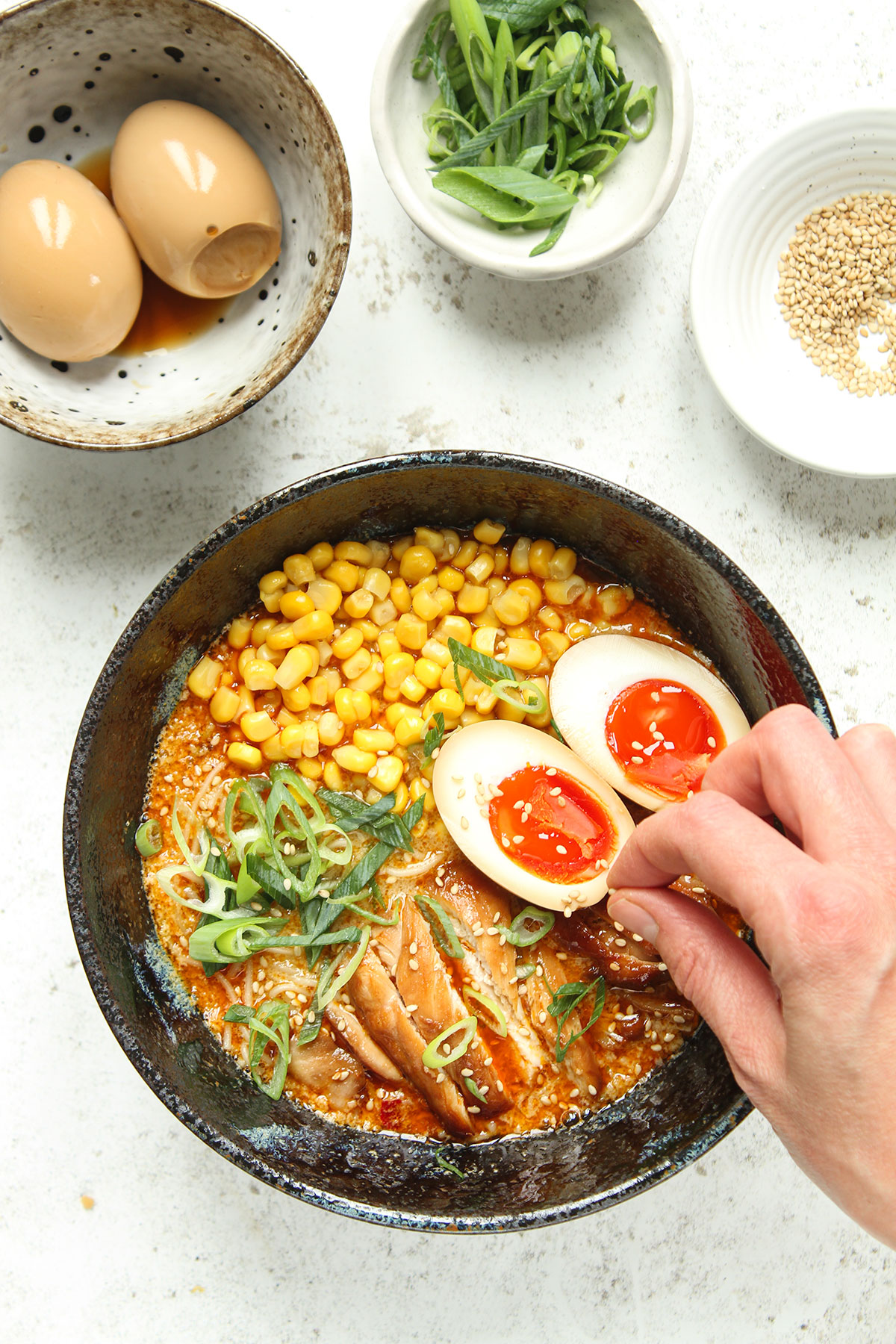
🍽️ Serving suggestions
A bowl of this miso ramen is nourishing, hearty and certainly a meal in itself. Here are a few suggestions if you fancy something extra on the side:
- Edamame beans
- Some Crispy Rice (with spicy salmon or tuna)
- Miso Glazed Eggplant/Aubergine
- Crunchy Sushi Rolls
- Gyoza or steamed dumplings
👍 Expert tips
- Don't skip the chicken marinade - it's really worth a little extra effort, trust me
- Have your toppings ready - to ensure you get the ramen on the table while it's still, hot and steamy
- Wait to cook the noodles - plan to drain them just before you assemble the ramen
- Serve as soon as the ramen is assembled - no one likes soft and mushy noodles
What to do with leftover miso paste
Wondering what to do with leftover miso paste? There are lots of ways to put it to a good use:
- Miso Glazed Eggplant/Aubergine
- Make this Miso Pasta in just 30 minutes
- Cook up a nourishing bowl of Mushroom Miso Soup
- Bake some tasty Browned Butter Miso Chocolate Chip Cookies
Thankfully, miso paste has a long shelf life, so there is plenty of time to try out different recipes. If you've had a jar of miso lingering in your fridge for a while and are not sure if it's still good, you should check out my 'How long does miso last in the fridge? Does it go bad?' article.
🙋 Recipe FAQs
Miso ramen is a popular Japanese noodle soup that is flavored with miso, a Japanese fermented soybean paste, which gives the broth a slightly sweet, salty and nutty taste. The soup typically consists of Chinese-style wheat noodles, broth, and toppings such as sliced pork, sliced green onions, and bean sprouts.
The Doubanjiang or chili oil gives the ramen a medium level of heat. You can easily adjust the amount to suit your taste and you can also skip it if you are very sensitive to spice.
This depends on the type of ramen and your desired flavor profile. White miso paste will give the ramen a light and sweet flavor, whereas red will add a more pungent savory taste. Most people prefer to make ramen with white miso paste or a mixture of the two.
Like many dishes, miso ramen can be considered a healthy meal when eaten in moderation. There are a few things you can do to reduce the fat and sodium and make it more nutritious including using whole wheat noodles, opting for a lower sodium broth, swapping fatty pork for lean chicken or tofu, and adding veggies like fresh steamed spinach or pak choi.
The best ramen is fresh ramen. I don't recommend storing an assembled bowl of ramen in the fridge to eat the next day. The toppings will get soggy and craggy.
However, you can prepare the broth ahead of time and store it in the fridge for up to 3 days. The same goes for the chicken and ramen eggs. All you need to do is warm the broth on the stove, cook up some fresh noodles and add the toppings.
You can also freeze the broth for up to 3 months, but of course, you can't freeze assembled ramen.
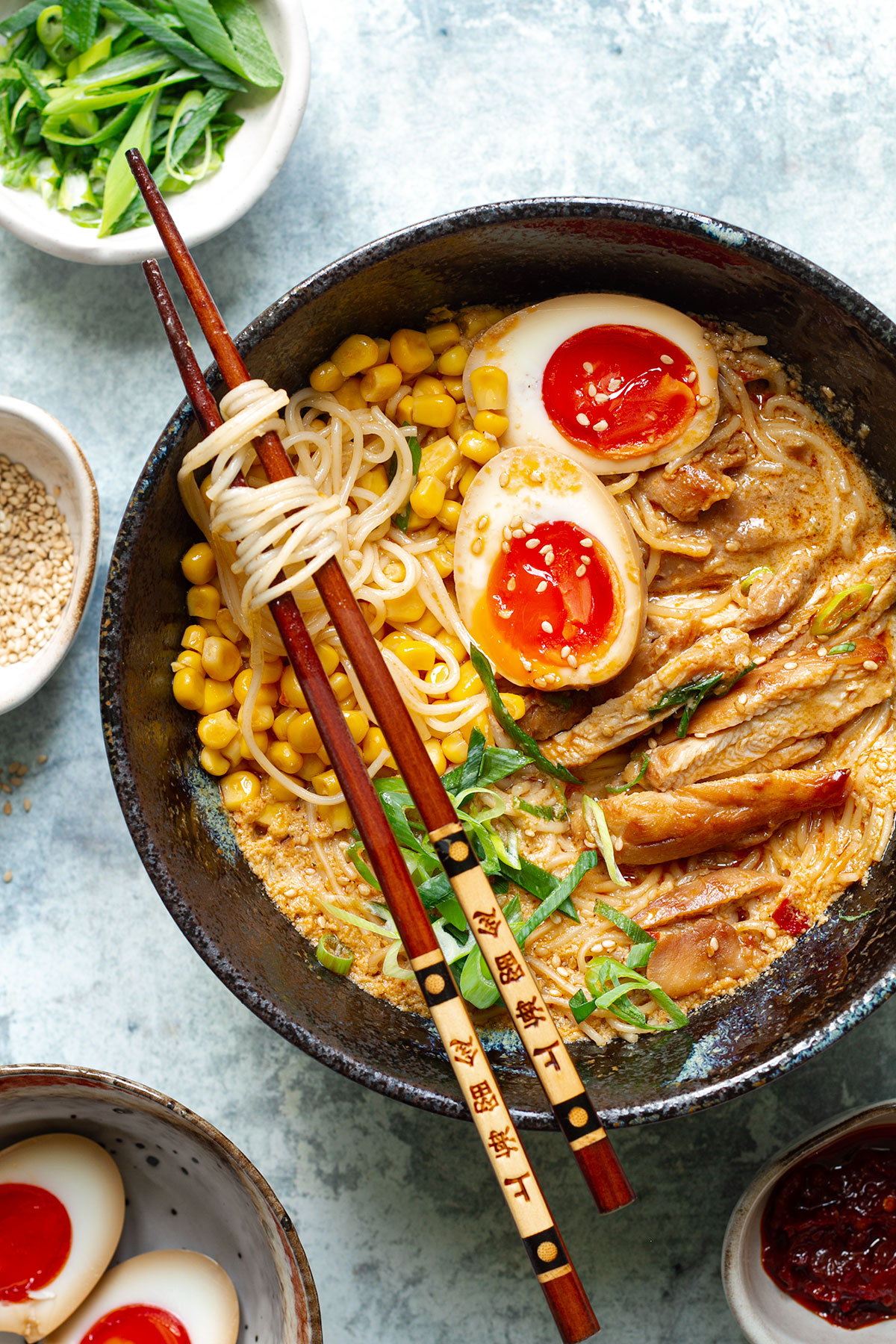
😋 Check out my other easy Japanese-inspired recipes
Did you try this recipe? It would be really great if you could leave a comment and a star rating ⭐️. I would love to receive your feedback and know that other readers find it helpful too.
Don't forget to tag #knifeandsoulrecipes on Instagram or @knifeandsoul on Pinterest!
📖 Recipe

Chicken Miso Ramen
Equipment
Ingredients
Chicken & marinade
- 2 chicken thighs (Note 1)
- 2 tbsp soy sauce (Note 2)
- 2 tbsp mirin (Note 3)
- 1 tsp sugar
Ramen ingredients
- 2 tbsp neutral oil (Note 4)
- 2 portions ramen noodles (Note 5)
- 2 cloves garlic finely grated
- 2 scallions/spring onions (white parts only) finely grated
- 2 tsp (5 g) ginger finely grated
- 2 tbsp miso paste (Note 6)
- 1 tbsp tahini
- 1 tbsp sesame oil
- 1 tbsp soy sauce
- ½ tbsp Doubanjiang or chilli oil (optional) (Note 7)
- 1 tsp sugar (Note 8)
- 2.5 cups (600 ml) chicken stock (Note 9)
Toppings
- 1 cup corn (Note 10)
- scallions/spring onions (green parts only) thinly sliced
- 2 soft-boiled ramen eggs (optional) (Note 11)
- toasted sesame seeds
Instructions
Chicken Marinade
- In a bowl, combine the marinade ingredients (soy sauce, mirin, and sugar) and stir until the sugar has dissolved.
- Remove any fat from the chicken thighs with scissors or a sharp knife.
- Add 2 chicken thighs to the marinade, cover and refrigerate for at least 30 minutes (ideally overnight).
Cook the chicken
- Place a pan on a medium heat and add half of the neutral oil. Add the chicken thighs when the oil is hot and fry for a few minutes on each side until brown.
- Increase the heat, pour in the rest of the marinade, and leave the chicken to simmer in the marinade, until cooked through. At this point the marinade will have reduced to form a sticky glaze.
- Remove the chicken from the pan when done, place onto a board and slice each thigh into ⅓ inch/1cm thick pieces.
Make the ramen broth
- Place a Dutch oven or large pan on a medium heat and add the remaining oil.
- Add the minced ginger, garlic and scallions/spring onion and fry for a minute or two until fragrant.
- Then add the miso paste, tahini, sesame oil, soy sauce, chilli oil and sugar and stir until incorporated.
- Pour on the chicken stock and allow to simmer for 10 minutes.
- Meanwhile, cook the ramen noodles according to packet instructions (plan to have them ready for when the ramen is ready to be assembled). Drain them while they are still slightly underdone. They will cook a little more when you add them to the broth.
Assemble
- Add a portion of cooked ramen noodles to each bowl and pour on the hot broth.
- Top each bowl with the cooked chicken, corn, soft boiled eggs and sliced scallions/spring onion. Serve immediately.
Notes
- Chicken thighs: you can substitute with chicken breast, pork or use tofu or fried mushrooms for vegetarian ramen. You can also use leftover cooked meat. In this case, skip the marinade, but you can make the sticky miso glaze using the marinade ingredients to give the meat extra flavor.
- Soy sauce: use regular or light, dark will be too rich.
- Mirin: Substitute with Chinese cooking wine OR dry sherry + 1 tsp white sugar.
- Oil: Use a neutral oil with a high burn point like sunflower, vegetable oil, canola or ground nut.
- Ramen noodles: Use fresh or dry or substitute with egg noodles. For gluten-free options use gluten-free ramen noodles or rice noodles.
- Miso paste: white miso paste is best and also the most readily available. Avoid using red miso, it will make the broth too strong.
- Doubanjiang: A spicy Chinese bean paste that also brings a slightly sweet umami flavor. Substitute with Chinese chili oil or feel free to leave it out if you prefer a non-spicy ramen.
- Sugar: used to balance out the saltiness of the broth rather than as a sweetener.
- Chicken stock: can use homemade or store-bought.
- Corn: use canned or frozen corn that has been thawed and warmed.
- Ramen eggs: make my Easy Soy Marinated Ramen Eggs or cook up regular soft-boiled eggs in simmering water for 6 minutes, leave to chill in icy or cold water and peel carefully.




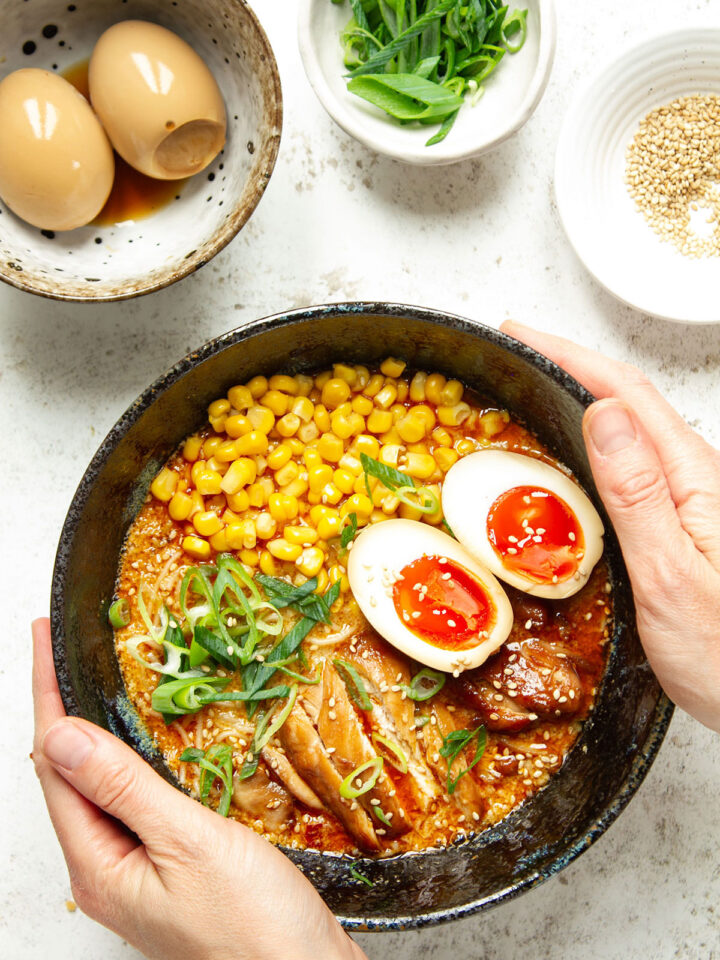
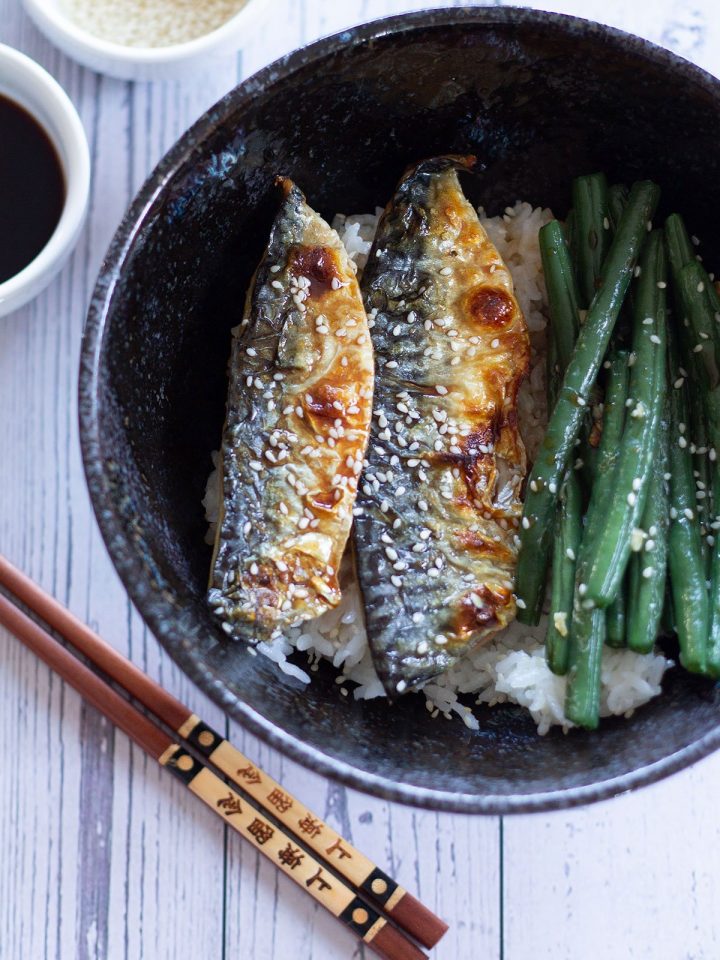

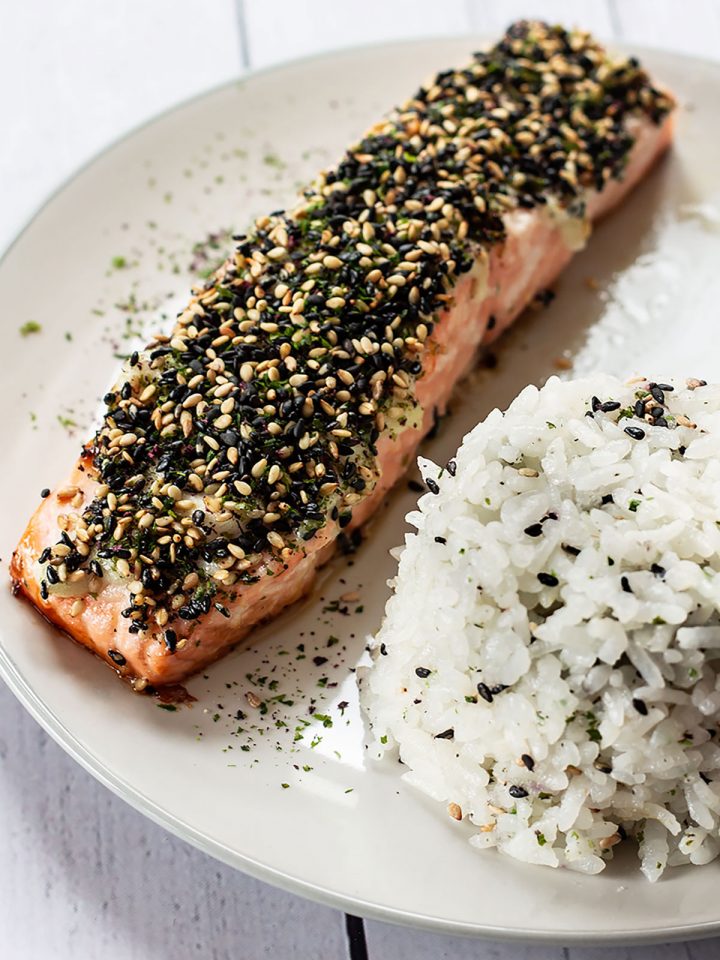
Leave a Reply